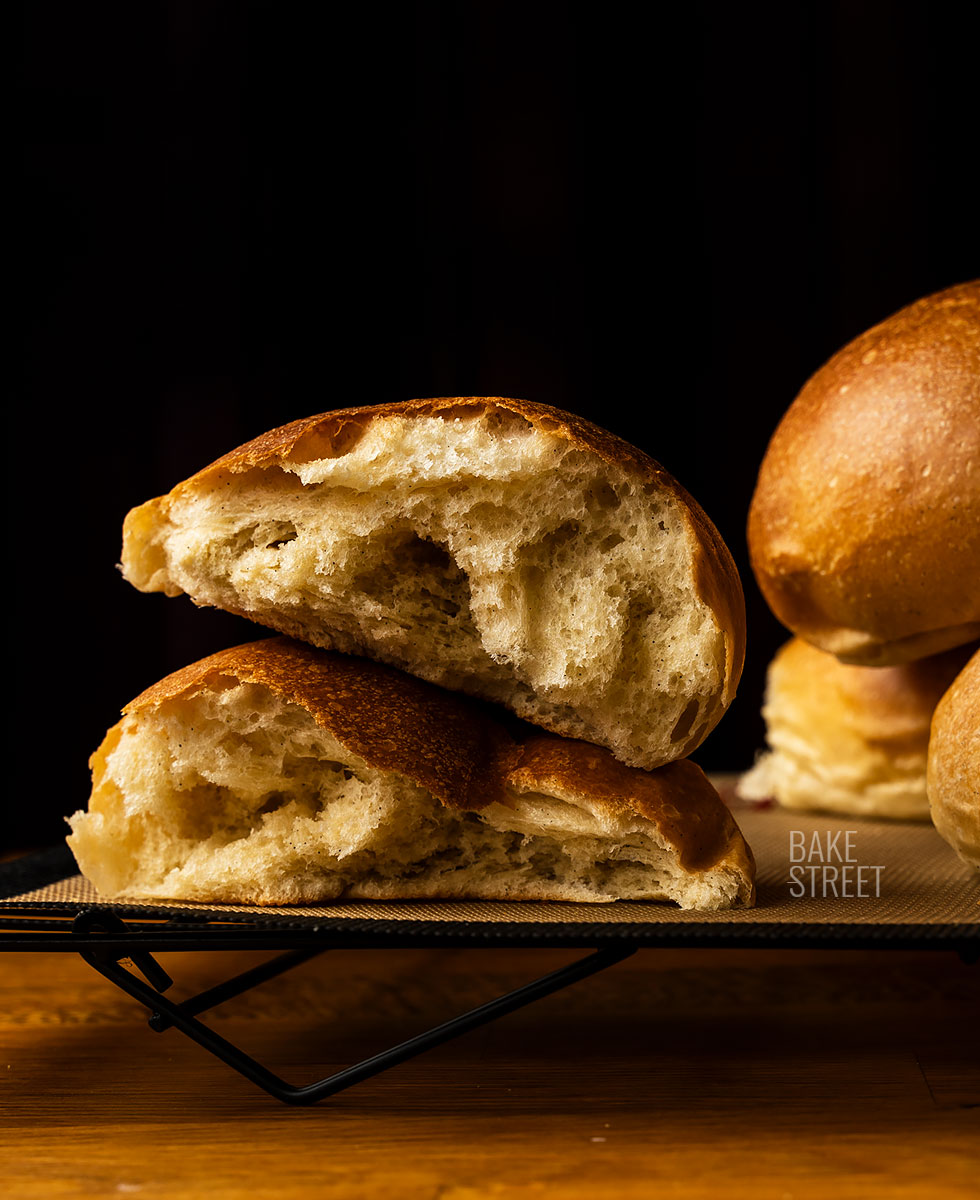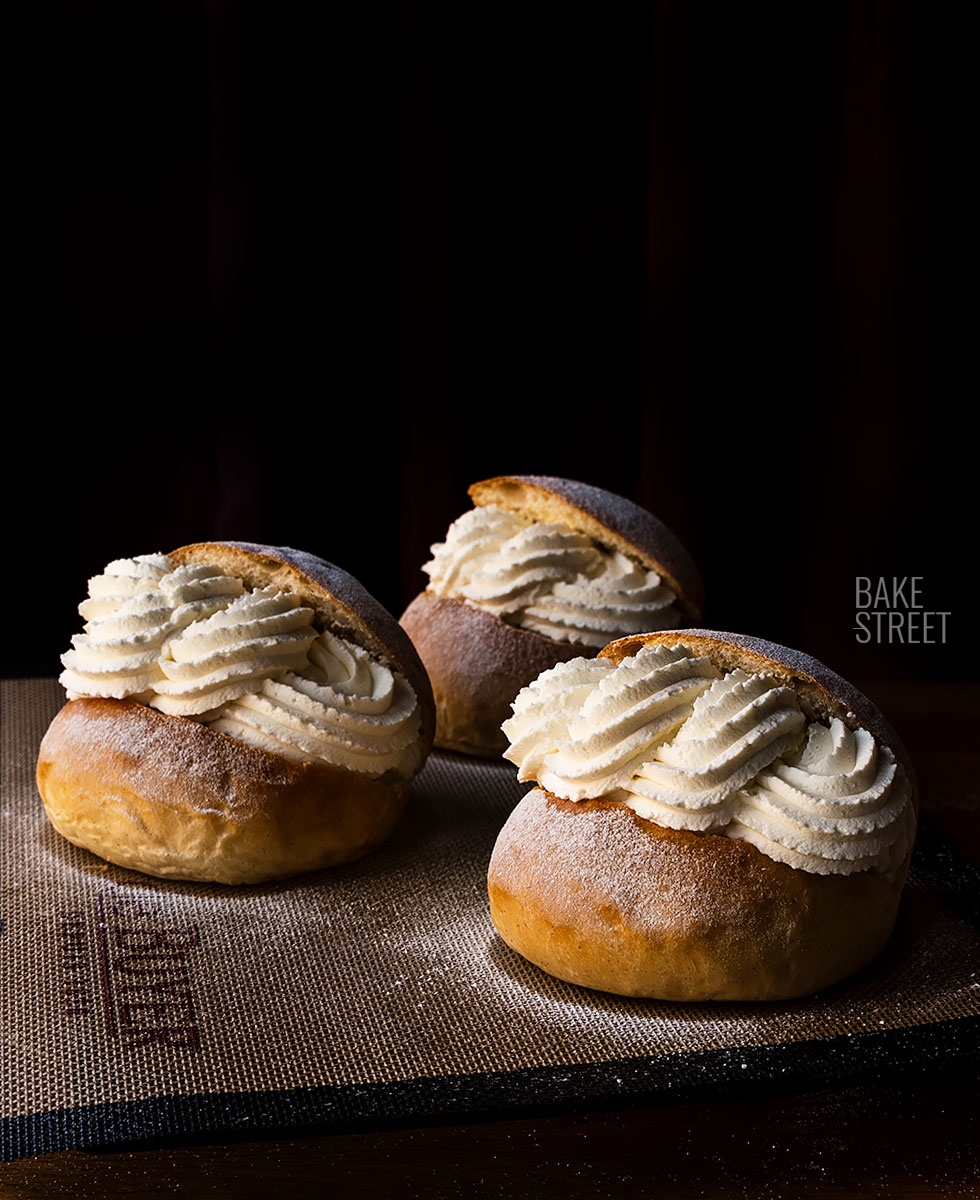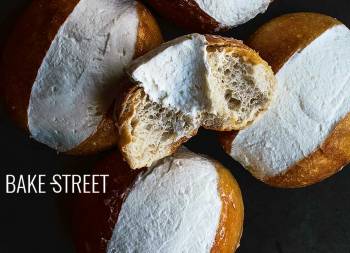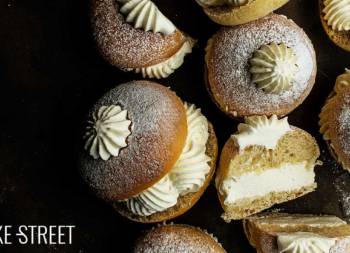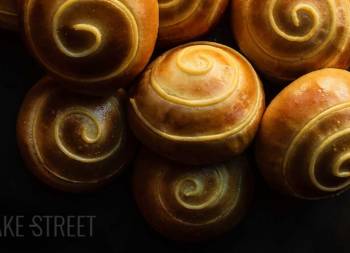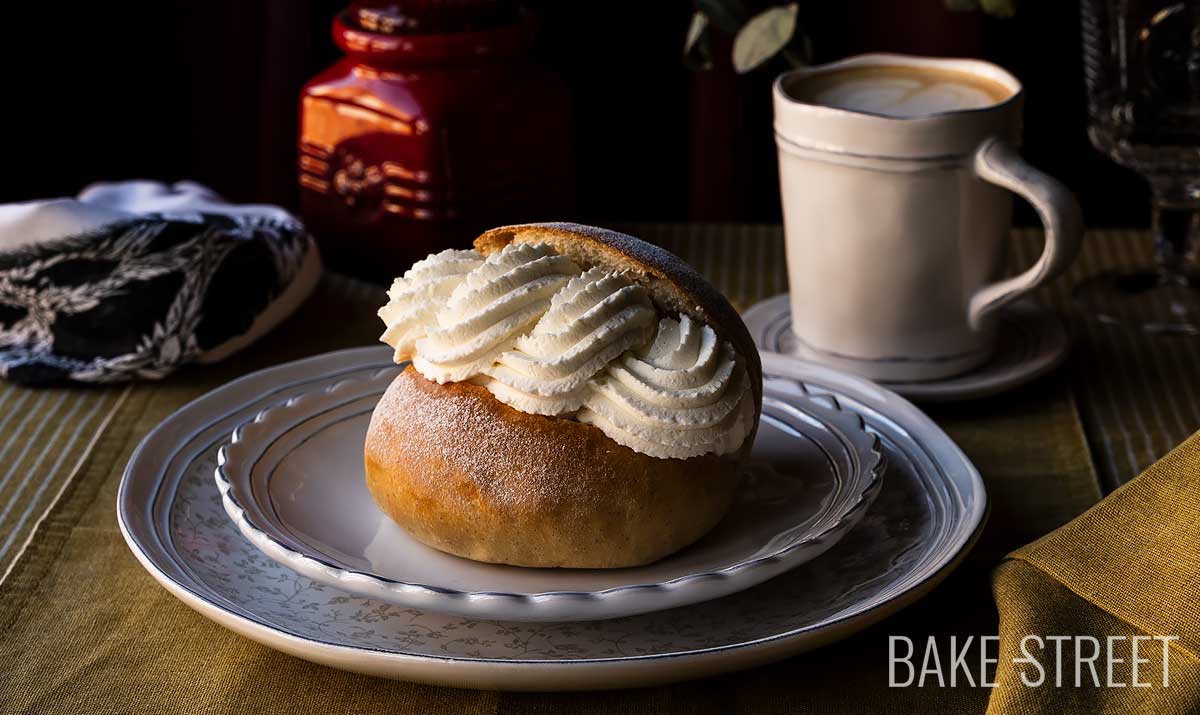
Bambas de nata – Sweet buns with whipped cream
Nothing better to start a Sunday than with a good breakfast, right? Today I bring you a classic, without much paraphernalia, but that usually has a good reception (especially in those who lived a childhood in the 80-90’s since it was a typical bun). I am referring to the traditional Bambas de Nata – Sweet buns with whipped cream or, also known as Cristinas.
The idea to carry out this recipe came thanks to a person who, during this Christmas, wrote me to ask me where she could buy some good Bambas de Nata in Madrid. Unfortunately, I couldn’t help her because the last ones I bought, at least I didn’t like them. I did recommend bakeries where she can go and buy good pastries, but I don’t think they have this one in particular. At least the times that I have gone to buy.
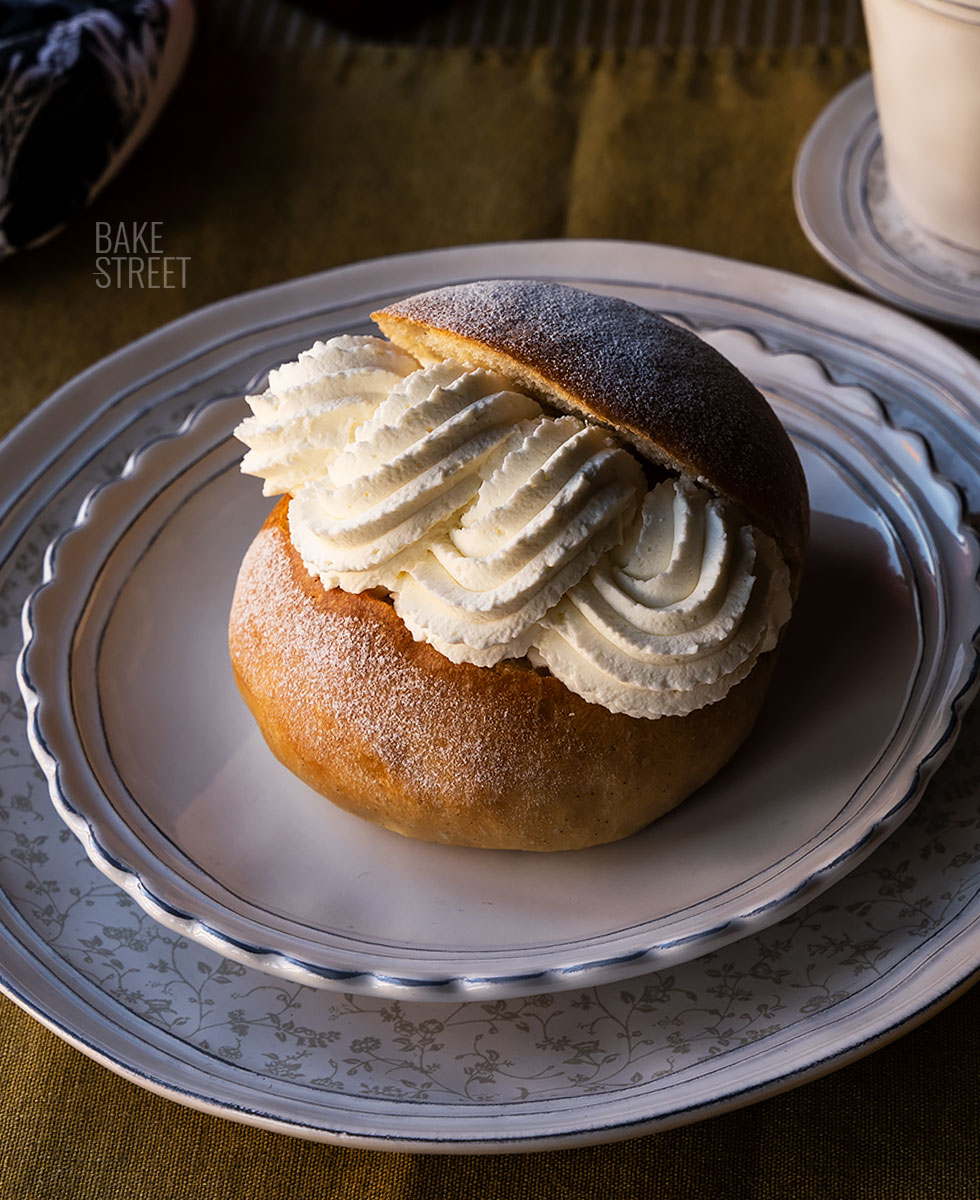
It is true that there are some sweets and pastries, very classic, that are difficult to find well made. It’s also true that I don’t go downtown as much as I used to and, surely, I’m missing out on pastry shops or bakeries that are worthwhile. I’m all ears to listen to your recommendations! Of course.
Thanks to her question, I decided to add it to the list of recipes to make.
The result was very good in the first test, so it moved forward in the calendar to be published. The recipe is not based on any traditional or original process. Starting from the basis of what this pastry is, a slightly enriched tender bun, I have elaborated a formula to create it. There are some doughs that are easy to formulate because they are very similar to other preparations. In this case, for example with bollo de mantequilla, Swiss roll or a less classic or traditional, lighter brioche.
To make this bamba de nata or Cristina, we will use two types of leavening agents; sourdough and yeast. Why? I really like to combine both elements to leaven some doughs. On the one hand we get the benefits of a natural and wild yeast; flavor, durability (for me, the most important) and a structure in the crumb that we only get with sourdough. By combining it with yeast, in moderate amounts, we enhance the leavening process and shorten the time. Without overdoing it, so as not to counteract just what the sourdough gives us.
In case you don’t have/want to use sourdough, you can elaborate a yeast pre-ferment or omit this ingredient and add the amount of water and flour used in the sourdough, without adding more yeast. I detail it better in the notes section, at the end of the post.
Bamba de Nata origin.
Bamba de nata (whipped cream) or filled with pastry cream, although the latter is less common than the former, also called “Cristina” in certain parts of Spain such as Galicia, Cantabria and Lérida, or “bomba” in other places such as Asturias and the Basque Country, for example, although the latter differs from the former because it is fried instead of baked. It is a sweet that, not too many years ago, was one of the protagonists of the showcases of pastry shops.
According to Diccionari català-valencià-balear del Institut d´Estudis Catalans, we find the definition of bamba as:
1. Bamba f.
|| 1. Espècie de coca (Ll., Val., Alcoi).
|| 2. adj. a) Pasta bamba (pasta bomba o choux pastry): pasta de farina, ous, sucre i oli (o saïm), molt blana i fina (Mall.).
b) Coca bamba: coca feta de la dita pasta (Mall., Men.).
It does not refer to this product carried out with filling. It is very likely that the famous bamba de nata, so well known in Madrid, is an adaptation or evolution of the coca bamba. Regarding the latter, it is a traditional pastry from Menorca. Its appearance is very similar to that of the ensaimada, only that unlike being a dough that is stretched to achieve an almost transparent dough and then rolled into a spiral shape, the coca bamba is a piece of pastry, a very tender and spongy dough, which is formed as a spiral. It is possible that the potato roll is a close cousin of this elaboration.
Both ensaimada and coca bamba, also called ensaimada from Menorca, can be found with whipped cream filling. I dare to say that bamba de nata has been the result of both elaborations, only trying to create a smaller or individual format.
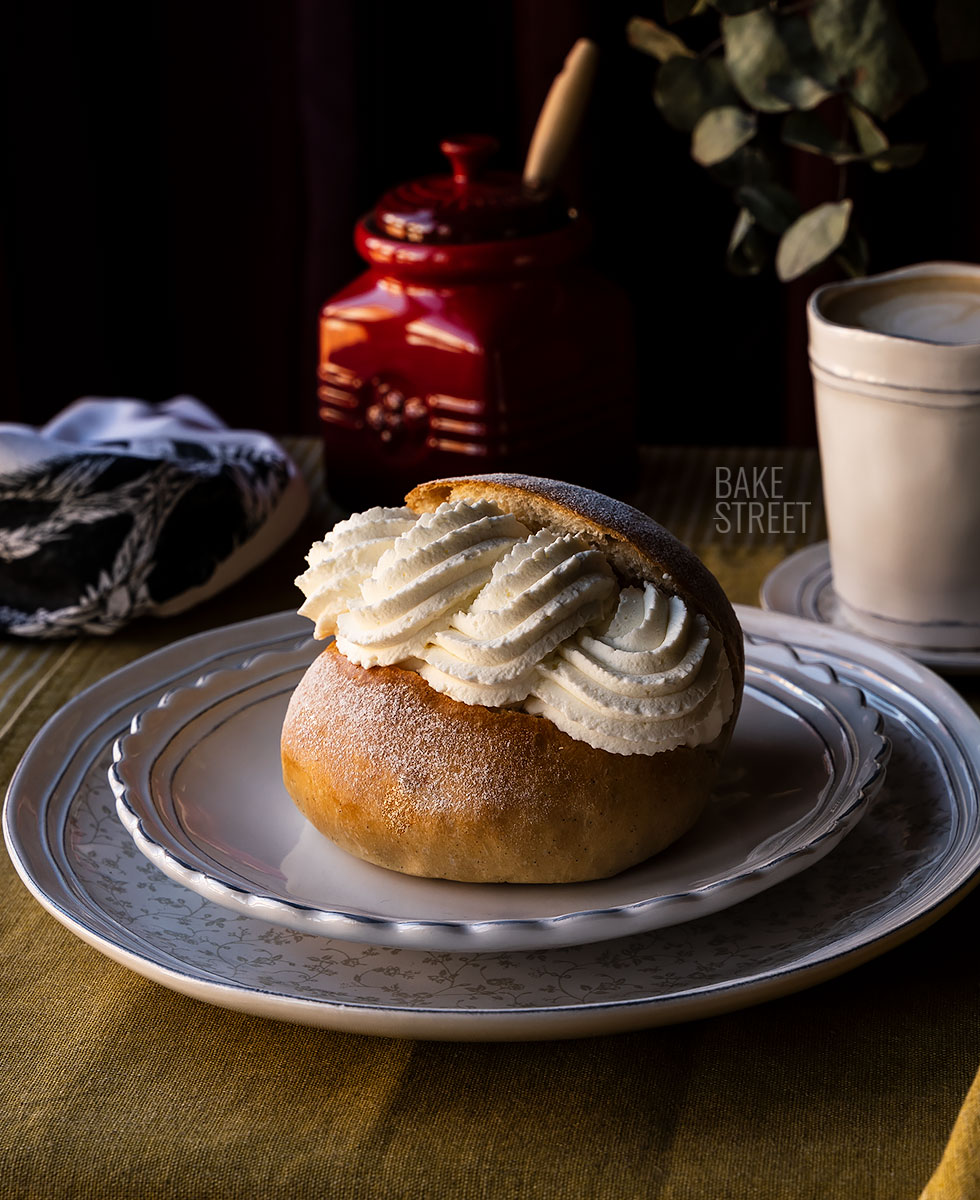
Although its origins are somewhat uncertain, its name comes from the Mallorcan saïm, which means lard.
The first written references to the ensaimada date back to the 17th century, in some documents that show how it was one of the sweets made especially for parties and celebrations in Mallorca.
On the other hand, there are also several beliefs about the origin of the ensaimada. One refers to its Jewish origin and another refers to its Arab origin:
- The Arabs, present on the island since 1909, made a snail-shaped sweet called bulemawith the same ingredients as the ensaimada except for the lard. It is also attributed to the Arab origin because of the curled shape like a turban.
- The other possible origin of the ensaimada is Jewish. The Jews used to make a bread called bulemafor the Sabbath. The Hebrew version was made in the form of a braided spiral and was full of symbolism.
According to Ana Cortés (daughter of Joseph Cortés) during her appearances before the court of the Majorcan Inquisition, carried out between December 30, 1677 and March 8 of the following year, speaking of the dishes that were prepared on the feast of Yom Kippur, she says:”para aquel dia se avia de hacer gran ostentación, y si podían hacer cocas bambas las hiciesen, y aún confitura también, si no que la hacen manos de la canalla que guardan la ley de gracia y por esso no la compraban“.
Nowadays “coca bamba de Sant Joan” is a typical pastry that is consumed in the celebrations of June 24 in Menorca and, in Catalonia, the coca de Sant Joan is made (here I left you a couple of sweet recipes; this oneand this one (savoury)).
As I have read in AdmReportaje, it is possible that the famous pastry-shop Mallorca could be related to the arrival of bambas de nata to Madrid. Bringing a typical elaboration of the islands, in a smaller format and with a very typical filling of the time, whipped cream.
They are very similar to the famous Chevaliers from Burgo, Swiss-shaped pastries decorated with laminated almonds and powdered sugar, filled with whipped cream or cream.
Recipe Bamba de nata
Ingredients for 6 pieces
LIQUID SOURDOUGH:
- 10 g 100% hydrated sourdough
- 20 g water
- 20 g T45 flour
DOUGH:
- 300 g T45 flour or bread flour (about W=280)
- 115 g egg (2 large eggs)
- 65 g whole milk
- 40 g sourdough
- 10 g fresh yeast or 3,3 g dry yeast
- 85 g unsalted butter, cold
- 1 tsp natural vanilla extract
- 50 g sugar
- 6 g salt
FILLING AND DECORATING:
- mascarpone cream, recipe below
- powdered sugar, for decorating
MASCARPONE CREAM (to fill 6 pieces):
- 530 g heavy cream, very cold
- 300 g mascarpone cheese, very cold
- 110 g powdered sugar
MATERIAL WE WILL NEED:
- perforated tray/baking tray
- perforated Silpat/silpat/teflon/parchment
- pastry brush
- scraper
- digital scale
- pastry bag + BS 118 nozzle
- digital kitchen thermometer (optional)
- cooling rack
Instructions
FIRST DAY
Prepare the dough.
- In the bowl of the mixer add the flour together with the eggs, milk, sourdough, yeast and sugar. Knead at low speed for 5 minutes. We will have to have a semi-developed dough in which we observe that the ingredients are amalgamated.
- After this time, add salt and vanilla extract. Raise to high speed and knead for 12 minutes.
- Stop the mixer and start adding the butter little by little. Allow the butter to fully integrate into the dough before adding more. During the whole process of incorporating the butter, we will knead at low speed.
- Once all the butter has been added and incorporated, knead for 5-8 more minutes at low speed. The dough should be elastic, soft, smooth and not break.
- Let it rest in the bowl, covered with film or plastic wrap for 45 minutes.
- Remove the dough, fold and place in a bowl previously greased with olive oil.
- Store in the refrigerator for 12-24 hours. In my case it was 12 hours at 39ºF/4ºC.
SECOND DAY
Let it double in volume and shape.
- Remove the dough from the refrigerator and, if it has not doubled in volume, let it do so.
- Before proceeding to divide the dough, we must leave it at room temperature for 1-2 hours to be able to handle it more easily.
- Divide the dough into 6 pieces of approximately 100-103 g each.
- Shape the dough gently, without exerting too much tension. The softer you handle the dough, the more tender the final result will be. Remember that if you have created scraps when dividing the dough, these should always remain in the center of the piece.
- In this case we will not preshape the dough, but shape it directly.
- Place the pieces on a perforated tray lined with baking paper, perforated silpat or Teflon.
- Grease the surface of each piece with olive oil, cover with film and let rise until doubled in size. In my case it was 2 and 1/2 hours to 82,4ºF/28ºC.
Bake.
- Preheat the oven to 338ºF/170ºC with heat up and down.
- Brush the surface of the buns with whole milk.
- Bake at medium height for 15-16 minutes. Remember that the internal temperature must reach 190º-194ºF/88º-90ºC for the baking to be finished.
- Remove from the oven, unmold and let cool completely on a wire rack.
- In the NOTES section, I tell you how to keep them for a long time.

Prepare mascarpone cream.
- Cream must be cold 24 hours before used it.
- The bowl in which we are going to make whipped cream must be cold (recommended).
- Pour heavy cream along with mascarpone cheese and icing sugar into a bowl and whisk with an electric mixer into low speed.
- Increase speed gradually but without reaches high one. Ideally use medium speed. Be sure not to over-beat, otherwise cream will become lumpy and butter-like.
- Transfer to a piping bag with BS 118.
- Place in the fridge until used it.
Fill.
- Cut each bun in half without reaching the other end so that they are not separated into two pieces, then proceed to fill them.
- Pipe mascarpone cream inside and then a waved string as I show you in the video.
- Sprinkle with powdered sugar on the surface.
- Serve.
- If there is any leftover bamba, it can be kept refrigerated in an airtight container or covered with plastic wrap for 24-48 hours.

Notes
- If we cannot find T45 flour, we can use a medium-strength flour W=280 approximately as a substitute. It is important to observe how the flour behaves, as we add ingredients, to know if it has enough absorption capacity. If you do not know the flour with which you are going to work, add the milk little by little.
- If you do not want to use sourdough in the recipe, omit it and instead add 40 g of T45 flour and 40 g of milk. It will not be necessary to increase the amount of yeast. If you wish, you can prepare a preferment with 100% hydration and add it in the same way as we do with the sourdough.
- Remember that 1 g of dry baker's yeast is equivalent to 3 g of fresh yeast.
- It is very important to knead well, handle the dough with care and carry out the fermentations correctly to achieve a tender and spongy result in our breads.
- Respect all the steps, resting and rising times to obtain a good result both in taste and texture.
- I recommend using a good quality butter because it will affect the final flavor of the dough.
- Spread olive oil on the surface of the uncooked dough pieces to prevent the film from sticking to them. This will prevent tears in the dough when we remove the film after the rising process.
- I have been avoiding brushing the doughs with beaten egg for some time now, I like the texture and final finish that we achieve with milk much better. In fact, I consider that it allows it to expand better without sealing the surface. In addition to having a smooth, light and very pleasant finish.
- Control the final baking time, in 15 minutes they will be ready, but it will depend a lot on how your oven works.
- The buns will keep in perfect condition for 4-5 days wrapped in film or in a freezer bag. From this point on, they will begin to lose their tenderness.
- If you wish, you can fill them only with whipped cream. In my case I like to combine it with mascarpone cream because we achieve much better consistency, besides not altering the flavor since it is a very soft and delicate variety of cheese.
- We can freeze them individually wrapped in film. They can be left to thaw overnight.

I hope you dare to prepare these Bambas de Nata at home and let me know what you think of them. I can already tell you that from the first bite you take, you will immediately go back to those moments of your childhood. Absolute happiness when your parents bought you one, followed by happy cheeks covered with whipped cream and powdered sugar. Well, and the tip of your nose too, hahaha.
I wish you a wonderful weekend!
Lots of love,
Eva
Sources: AdmReportaje,Isla de Menorca
